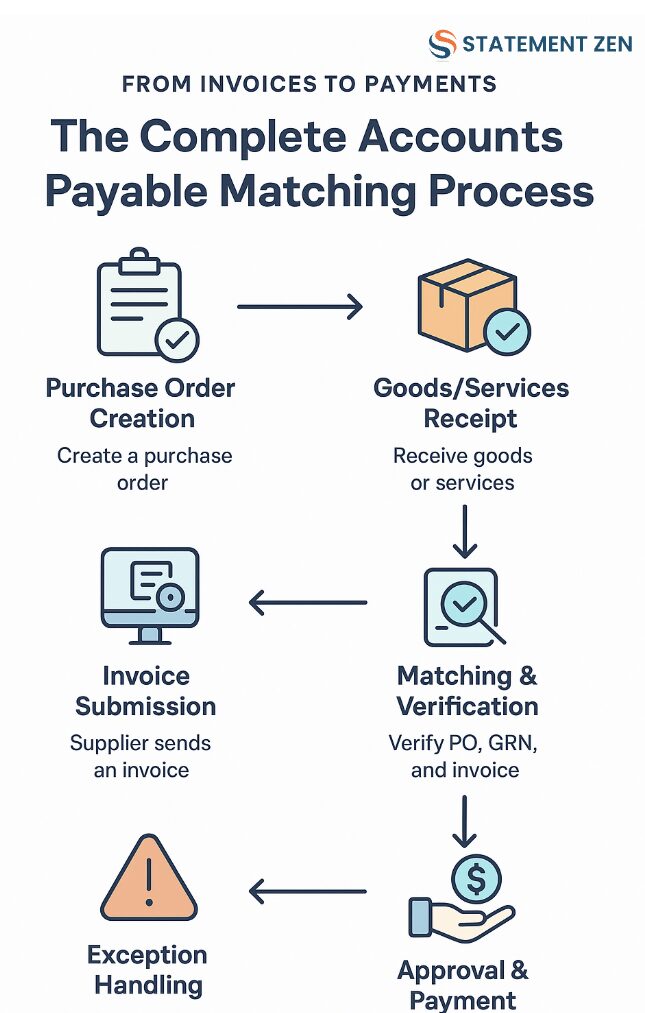Accounts Payable (AP) isn’t just about paying bills — it’s about paying the right bills, for the right amounts, at the right time.
Without a robust accounts payable matching process, you risk duplicate payments, missed credits, overpayments due to pricing errors, and supplier disputes that could have been avoided entirely.
In this guide, we’ll break down how AP matching works from invoices to payments, why 3-way matching is still the gold standard, and how to streamline the entire invoice processing workflow so you can close your books faster and with fewer headaches.
What is Accounts Payable Matching?

At its core, accounts payable matching is a control process that verifies the accuracy of supplier invoices before payment.
It compares critical documents — like purchase orders, goods receipt notes, and supplier invoices — to make sure that:
- You actually ordered the goods or services.
- They were delivered in full and in good condition.
- You’re being charged the correct price, tax, and terms.
This isn’t “nice to have” — it’s an essential guardrail for cash flow integrity. Think of it like locking the vault before you walk away.
The 3 Types of AP Matching
While all AP matching has the same goal — accuracy and fraud prevention — the method you choose depends on your control needs.
1. 2-Way Matching
- What’s compared? Purchase order (PO) vs. invoice.
- Use case: Low-risk suppliers or recurring service contracts.
- Risk: Doesn’t confirm actual delivery, so discrepancies in received goods can slip through.
2. 3-Way Matching
- What’s compared? Purchase order vs. goods receipt note vs. invoice.
- Use case: Physical goods procurement where quantity and quality matter.
- Benefit: Ensures payment is only made for items ordered and received.
3. 4-Way Matching
- What’s compared? Same as 3-way, but adds inspection or quality acceptance records.
- Use case: High-value, critical goods where compliance and standards are non-negotiable.
- Benefit: Eliminates payment risk for defective or non-compliant goods.
The Complete AP Matching Workflow: From Invoices to Payments

Let’s walk through what an ideal AP matching process looks like in practice.
Step 1: Purchase Order Creation
Everything starts with a PO. This is the blueprint — specifying:
- Item descriptions
- Quantities
- Unit prices
- Delivery terms
If the PO isn’t right, everything downstream will fail.
Step 2: Goods/Services Receipt
Once the supplier delivers, your receiving team logs a Goods Receipt Note (GRN) or service confirmation.
This is proof of what physically arrived — quantities, condition, and delivery date.
Step 3: Invoice Submission
The supplier sends an invoice referencing the PO. This should match agreed terms exactly — no surprise surcharges, incorrect quantities, or mismatched tax.
Step 4: Matching & Verification
Here’s where the magic happens. Depending on your method:
- 2-way matching compares PO to invoice.
- 3-way matching adds GRN into the mix.
The system (or your AP team) checks:
- Quantities match.
- Unit prices align.
- Tax calculations are correct.
- Any credits or discounts are applied.
Step 5: Exception Handling
If something doesn’t match, it becomes an exception:
- Wrong quantity
- Missing GRN
- Price discrepancy
- Unapplied credit
The AP team investigates before approving payment.
Step 6: Approval & Payment
Once matched, the invoice is approved for payment. Depending on your setup, you may leverage:
- Early payment discounts
- Scheduled batch payments
- Automated payment runs through AP automation tools
Why 3-Way Matching Still Rules
While AI-powered automation is changing AP workflows, 3-way matching remains the backbone of payment accuracy.
It not only protects cash flow but also:
- Reduces supplier disputes by catching issues early.
- Strengthens your audit trail.
- Improves supplier trust (because you’re consistent and fair).
Even if you automate, the principle of verifying before paying never changes.
Common AP Matching Pitfalls (and How to Avoid Them)
Even the most disciplined AP teams fall into traps:
| Pitfall | Consequence | How to Fix |
|---|---|---|
| Skipping the match for “trusted” suppliers | Duplicate or fraudulent payments | Always follow the process, no exceptions |
| Rushing matches at month-end | Missed credits, wrong totals in financials | Spread matching workload throughout the month |
| Manual data entry errors | Discrepancies and wasted hours fixing them | Use AP automation with OCR and AI validation |
| Poor document control | Lost POs, GRNs, or invoices | Centralize documents in a cloud-based AP system |
How Automation Transforms AP Matching
Manual matching is slow, error-prone, and costly. An automated statement matching or AP matching engine can:
- Match at scale — hundreds or thousands of invoices in minutes.
- Flag exceptions automatically, routing them to the right person.
- Integrate with your ERP for real-time updates.
- Give you clear, auditable records for compliance.
With automation, your AP team shifts from “document checkers” to financial problem-solvers.
Supplier Statement Matching: The Missing Layer
Even with perfect invoice-to-PO matching, discrepancies can hide at the statement level.
Supplier statement matching compares your AP ledger against the supplier’s statement to spot:
- Missing invoices
- Unapplied credits
- Payments not recorded on the supplier’s side
It’s a safety net that ensures your books and your supplier’s records align — critical for smooth month-end closes.
The ROI of a Tight AP Matching Process
The financial case for investing in AP automation and strong matching controls is undeniable.
Example ROI calculation:
- Time saved: 200 hours/month in manual matching × $25/hour = $5,000/month.
- Credits recovered: $50,000/year from unapplied credits.
- Early payment discounts: 1% discount on $2M annual spend = $20,000/year.
That’s $130,000+ in measurable value, before even counting intangible gains like supplier goodwill.
Best Practices for AP Matching
- Standardize Your Process
Document it so every AP team member works the same way. - Leverage Automation
Use an AP matching system with OCR, AI, and ERP integration. - Check Statements Monthly
Don’t wait for year-end — find and fix discrepancies early. - Prioritize Exceptions
Focus on high-value mismatches first to protect cash flow. - Audit Your Process Annually
Ensure controls still align with company goals and compliance requirements.
Final Word: Protect Every Dollar
Accounts payable matching isn’t just a finance admin task — it’s a strategic safeguard for your company’s cash.
When you combine strong process discipline with the right automation tools, you don’t just save time — you prevent losses, strengthen supplier trust, and free your AP team to focus on higher-value work.
If you’re ready to take your matching process from manual and reactive to automated and proactive, explore our AP matching automation platform and see how it can transform your workflow.
